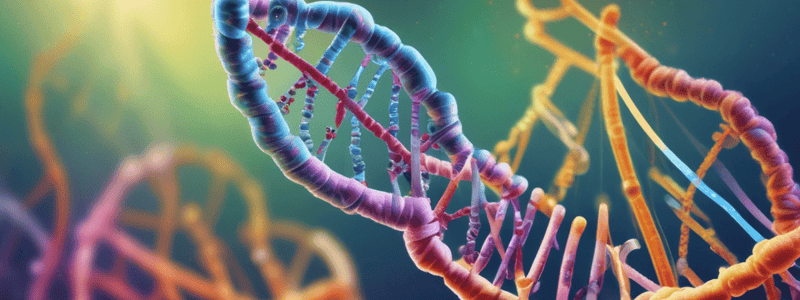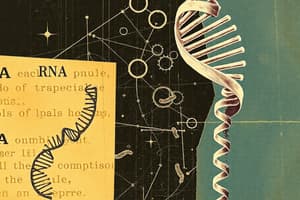Podcast
Questions and Answers
Where does splicing occur?
Where does splicing occur?
- In the ribosome
- During transcription
- In the cytoplasm
- At the spliceosome, within the nucleus (correct)
What is the purpose of capping and tailing in mRNA?
What is the purpose of capping and tailing in mRNA?
- To confer stability and facilitate ribosome binding in the cytoplasm
- Both a and b (correct)
- To facilitate export of the mRNA from the nucleus
- To remove introns from the transcript
What is the definition of exons?
What is the definition of exons?
- Untranslated regions at the 5' and 3' ends of mRNA
- Intervening regions that remain in mature RNA
- Regions that do not remain in mature RNA
- Regions that remain in mature RNA, including UTR (correct)
What is the purpose of alternative splicing?
What is the purpose of alternative splicing?
What is the definition of introns?
What is the definition of introns?
What is the relationship between the number of genes and the number of proteins in a cell?
What is the relationship between the number of genes and the number of proteins in a cell?
What is the main role of transfer RNA (tRNA) in the translation process?
What is the main role of transfer RNA (tRNA) in the translation process?
What is the role of the initiator tRNA in the initiation of translation?
What is the role of the initiator tRNA in the initiation of translation?
What is the primary role of GTP during the translation process?
What is the primary role of GTP during the translation process?
What is the primary role of the large ribosomal subunit during the initiation of translation?
What is the primary role of the large ribosomal subunit during the initiation of translation?
What is the primary function of the release factors during the termination of translation?
What is the primary function of the release factors during the termination of translation?
Why is the control of gene expression important?
Why is the control of gene expression important?
Where does all translation start?
Where does all translation start?
What directs ribosomes to the RER?
What directs ribosomes to the RER?
In which organelle does a secretory protein like insulin get solubilized?
In which organelle does a secretory protein like insulin get solubilized?
What is a common post-translational modification for membrane-bound proteins?
What is a common post-translational modification for membrane-bound proteins?
Which modification involves the addition of a phosphate group?
Which modification involves the addition of a phosphate group?
Where can post-translational modifications occur?
Where can post-translational modifications occur?
What is the correct order of the main steps in transcription?
What is the correct order of the main steps in transcription?
Which of the following is NOT a component of the transcription initiation complex?
Which of the following is NOT a component of the transcription initiation complex?
During elongation, where does the incoming RNA nucleotide bind?
During elongation, where does the incoming RNA nucleotide bind?
What is the signal for transcription termination?
What is the signal for transcription termination?
What is added to the 5' end of the pre-mRNA transcript during capping?
What is added to the 5' end of the pre-mRNA transcript during capping?
Why are poly-A tails added to the 3' end of the pre-mRNA transcript?
Why are poly-A tails added to the 3' end of the pre-mRNA transcript?
What is the main topic covered in the provided resources?
What is the main topic covered in the provided resources?
Which process is responsible for breaking down proteins?
Which process is responsible for breaking down proteins?
What is the purpose of the provided video links?
What is the purpose of the provided video links?
Which of the following is mentioned as a future lecture topic?
Which of the following is mentioned as a future lecture topic?
What is the purpose of the provided image resource?
What is the purpose of the provided image resource?
Flashcards
What is RNA splicing?
What is RNA splicing?
Splicing removes non-coding sequences (introns) from a pre-mRNA molecule, connecting the coding sequences (exons) to form a mature mRNA.
What is capping?
What is capping?
A modified guanine nucleotide is added to the 5' end of mRNA during processing, protecting it from degradation and aiding in ribosome binding.
What is tailing?
What is tailing?
A poly-A tail is added to the 3' end of mRNA, increasing stability and facilitating export from the nucleus.
What are exons?
What are exons?
Signup and view all the flashcards
What are introns?
What are introns?
Signup and view all the flashcards
How does alternative splicing increase protein diversity?
How does alternative splicing increase protein diversity?
Signup and view all the flashcards
Why is there a discrepancy between the number of genes and proteins?
Why is there a discrepancy between the number of genes and proteins?
Signup and view all the flashcards
What is the role of tRNA in translation?
What is the role of tRNA in translation?
Signup and view all the flashcards
What is the role of the initiator tRNA?
What is the role of the initiator tRNA?
Signup and view all the flashcards
What is the role of GTP in translation?
What is the role of GTP in translation?
Signup and view all the flashcards
How is a functional ribosome assembled?
How is a functional ribosome assembled?
Signup and view all the flashcards
How does translation terminate?
How does translation terminate?
Signup and view all the flashcards
Why is controlling gene expression important?
Why is controlling gene expression important?
Signup and view all the flashcards
Where does translation start?
Where does translation start?
Signup and view all the flashcards
How are ribosomes directed to the RER?
How are ribosomes directed to the RER?
Signup and view all the flashcards
How are secretory proteins processed in the ER?
How are secretory proteins processed in the ER?
Signup and view all the flashcards
What are common post-translational modifications and their significance?
What are common post-translational modifications and their significance?
Signup and view all the flashcards
What is phosphorylation?
What is phosphorylation?
Signup and view all the flashcards
Where can post-translational modifications occur?
Where can post-translational modifications occur?
Signup and view all the flashcards
Where and how does transcription initiate?
Where and how does transcription initiate?
Signup and view all the flashcards
What happens during transcription elongation?
What happens during transcription elongation?
Signup and view all the flashcards
How does transcription terminate?
How does transcription terminate?
Signup and view all the flashcards
Why is protein degradation important?
Why is protein degradation important?
Signup and view all the flashcards
What will future lectures focus on?
What will future lectures focus on?
Signup and view all the flashcards
What is the purpose of the video links?
What is the purpose of the video links?
Signup and view all the flashcards
What is the purpose of the image resource?
What is the purpose of the image resource?
Signup and view all the flashcards
What is not a component of the transcription initiation complex?
What is not a component of the transcription initiation complex?
Signup and view all the flashcards
Study Notes
mRNA Processing and Structure
- Splicing occurs in the nucleus, removing introns and joining exons together.
- Capping involves adding a modified guanine nucleotide to the 5' end of mRNA, protecting it from degradation and aiding in ribosome binding.
- Tailing adds a poly-A tail to the 3' end of mRNA which enhances stability and facilitates export from the nucleus.
- Exons are coding sequences in the gene that remain in the mRNA after splicing.
- Introns are non-coding sequences that are removed during RNA processing.
Alternative Splicing and Gene-Protein Relationship
- Alternative splicing allows for the production of multiple protein variants from a single gene, increasing diversity without duplicating genetic material.
- There is a disparity between the number of genes and proteins; one gene can encode multiple proteins through alternative splicing and post-translational modifications.
Translation Process
- Transfer RNA (tRNA) plays a crucial role in translating mRNA code into polypeptide chains by delivering specific amino acids to the ribosome.
- The initiator tRNA recognizes the start codon on mRNA and carries the first amino acid, typically methionine, beginning the polypeptide chain.
- GTP serves as an energy source during translation, powering the tRNA attachment and ribosome movement.
- The large ribosomal subunit assembles with the small subunit at the initiation phase, facilitating the formation of the functional ribosome for protein synthesis.
- Release factors terminate translation by recognizing stop codons and prompting ribosome disassembly and release of the polypeptide.
Gene Expression and Translation Initiation
- Controlling gene expression is vital for cellular function, allowing adaptation to changes and regulation of various pathways.
- Translation starts at the start codon, typically AUG, on the mRNA strand.
- Ribosomes are directed to the rough endoplasmic reticulum (RER) by signal sequences on the nascent polypeptide.
Protein Processing and Modifications
- Secretory proteins, such as insulin, are solubilized in the endoplasmic reticulum (ER).
- Common post-translational modifications for membrane-bound proteins include glycosylation and lipidation.
- Phosphorylation is the process of adding a phosphate group, which can alter protein activity and function.
- Post-translational modifications can occur in various organelles, including the ER, Golgi apparatus, and cytoplasm.
Transcription Process
- The main steps in transcription include initiation, elongation, and termination.
- RNA polymerase, transcription factors, and the promoter are components of the transcription initiation complex, while DNA is not considered a component.
- During elongation, incoming RNA nucleotides bind to the 3' end of the growing mRNA strand.
- The transcription termination signal typically includes specific sequences in DNA recognized by RNA polymerase, stopping transcription.
Additional Topics
- The main topic revolves around molecular biology concepts including RNA processing, translation, and gene regulation.
- Protein degradation processes are critical for maintaining cellular homeostasis.
- Future lecture topics may cover advanced mechanisms of gene expression regulation.
- Provided video links serve as supplemental resources for visual learning and deeper understanding of the subject matter.
- The purpose of the given image resource is to illustrate processes or structures related to the discussed concepts in molecular biology.
Studying That Suits You
Use AI to generate personalized quizzes and flashcards to suit your learning preferences.




